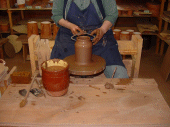|

Pottery was first developed over 10,000 years ago and is considered one of the oldest art forms in the world. In 500 BC, in Europe, unglazed earthenware was the most common form of pottery, and the beginning of the type of pottery that is made in Sherbrooke Village.
Many of the early potters set up their shops in barns or sheds and required an assistant to help with the numerous steps required to ensure quality pottery. The steps include: removing the rocks, weighing the clay, kneading, coning, centering, shaping, glazing, and firing.
First, the potter had to be certain that the clay contained no rocks, which would cause the pottery to chip when heated in the kiln. The clay was weighed for each piece that would be made that day, and kneaded in order to remove excess air. Once the clay was placed on the wheel, it was coned to align the particles, and make it more elastic. The potter then centered the clay in the middle of the wheel and began shaping the piece. Once the desired shape had been achieved, the clay was left to dry.
The clay then underwent a bisque firing at 1,740 degrees Fahrenheit (1,067 degrees Celsius). After the first firing, the pot was glazed, loaded into the kiln, and fired again at over 1,900 degrees Fahrenheit (1,167 degrees Celsius). The kilns were heated with wood and required constant attention. Any fluctuations in the temperature could have ruined the pottery. After firing, the pot had to cool for half a day and be soaked in water to remove surface dirt.
Once the entire pot had dried, glaze was poured into it until the pot was 1/3 full and it was tipped and turned until the inside was completely covered. Once the inside had been given an opportunity to dry, the outside was ready to be dipped. The glaze used was colourless and made from powdered clays, sand, flux, and water. Occasionally powdered glass would have been used to give the glaze a luster.
The potters of Sherbrooke Village throw reproductions of the antique pottery found in the area, using clay from Lantz, Nova Scotia, about 3,000 pounds a year. The clay that has been mined in Lantz since the 1800s is called earthenware, and has a reddish brown colour, the result of a high iron content. With the exception of a modern kiln, the process used at the Village dates back to the 1800s, including the use of a traditional 150 pound kick wheel.
Click for more pictures and movies

|

|

|
|